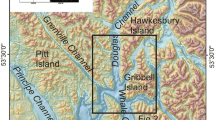Abstract
A simple reconstruction technique for sedimentary basins formed on ductile substrata is introduced. This technique is based on backstripping method and assumes the preservation of bed lengths. First, a seismic section for a sedimentary basin is interpreted and converted into a depth section. The interpreted horizons are divided by tick marks, from the basin axis out toward the basin margins, into a number of equally-spaced line segments. Then, each sediment layer is removed by moving the tick marks on the lower boundary of the layer to the corresponding tick marks on the upper boundary, thereby preserving the bed lengths. Decompaction correction is made to add the amount of expansion after removal of each sediment layer. The seafloor or bathymetry is adjusted after decompaction correction. Backstripping, decompaction correction, and seafloor adjustment are repeated until the deepest sediment layer is left in the basin.
This technique is applicable to the analysis of monotonously subsiding basins formed by withdrawal of ductile substrata. It may also be applicable, to a limited extent, to intracratonic basins with simple subsidence histories.
Similar content being viewed by others
References
Baldwin, B. and Butler, C.O., 1985, Compaction curves. American Association of Petroleum Geologists Bulletin, 69, 622–626.
Bruce, C.H., 1973, Pressured shale and related sediment deformation: mechanism for development of regional contemporaneous faults. American Association of Petroleum Geologists Bulletin, 57, 878–886.
Dix, C.H., 1955, Seismic velocities from surface measurements. Geophysics, 20, 68–86.
Dykstra, J., 1987, Compaction correction for burial history curve: application to Lopatin's method for source rock maturation determination. Geobyte, 2, 16–23.
Gibbs, A.D., 1983, Balanced cross-section construction from seismic sections in areas of extensional tectonics. Journal of Structural Geology, 5, 153–160.
Jackson, M.P.A. and Galloway, W.E., 1984, Structural and Depositional Styles of Gulf Coast Tertiary Continental Margins: Application to Hydrocarbon Exploration. American Association of Petroleum Geologists, Continuing Education Course Note Series 25, 226 p.
Jackson, M.P.A. and Vendeville, B.C., 1994, Initiation of Salt Diapirism by Regional Extension: Global Setting, Structural Style, and Mechanical Models. Report of Investigation, 215, Bureau of Economic Geology, University of Texas, Austin, 39 p.
Price, N.J. and Cosgrove, J.W., 1990, Analysis of Geological Structures. Cambridge University Press, Cambridge, 502 p.
Rowan, M.G., 1993, A systematic technique for the sequential restoration of salt structures. Tectonophysics, 228, 331–348.
Rowan, M.G. and Kligfield, R., 1989, Cross section restoration and balancing as aid to seismic interpretation in extensional terrains. American Association of Petroleum Geologists Bulletin, 73, 955–966.
Schultz-Ela, D.D., 1991, Practical restoration of extensional cross sections. Geobyte, 6, 14–23.
Spindler, W.M., 1977, Structure and stratigraphy of a small Plio-Pleistocene depocenter, Louisiana continental shelf. Gulf Coast Association of Geological Societies Transactions, 27, 180–196.
Twiss, R.J. and Moores, E.M., 1992, Structural Geology. W.H. Freeman and Company, New York, 532 p.
Woodward, N.B., Boyer, S.E. and Suppe, J., 1989, Balanced Geological Cross-Sections: an Essential Technique in Geological Research and Exploration. American Geophysical Union, Washington, D.C., 132 p.
Worrall, D.M. and Snelson, S., 1989, Evolution of the northern Gulf of Mexico, with emphasis on Cenozoic growth faulting and the role of salt. In: Bally, A.W. and Palmer, A.R. (eds.), The Geology of North America—an Overview. Geological Society of America, Decade of North American Geology, A, p. 97–138.
Author information
Authors and Affiliations
Corresponding author
Rights and permissions
About this article
Cite this article
Lee, G.H. Reconstruction of sedimentary basins formed on ductile substrata. Geosci J 3, 43–48 (1999). https://doi.org/10.1007/BF02910233
Received:
Accepted:
Issue Date:
DOI: https://doi.org/10.1007/BF02910233




